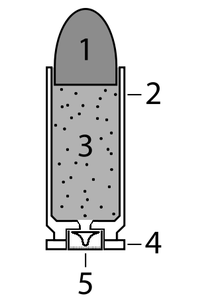This is a modern cartridge:
1. the bullet/projectile
2. the case; holds all parts together
3. the propellant (ie: gunpowder)
4. the rim; a place to grip the casing to remove it from the chamber once fired
5. the primer; ignites the propellant
Between 1854 and 1857 Sir Joseph Whitworth conducted a series of rifle experiments and proved the advantages of an elongated bullet. In 1882 Major Eduard Rubin invented the copper jacketed bullet - and elongated bullet with a lead core in a copper jacket. The surface of lead bullets fired at a high velocity may melt due to hot gases behind the bullet. Because copper has a higher melting point and hardness, copper jacketed bullets allow greater muzzle velocities.

